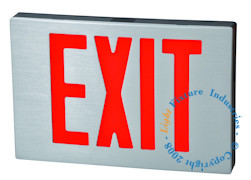The push to “Go Green” has been gaining steam in the past decade. From small businesses trying to save money on their electric bill to multi-billion dollar corporations needing to meet certain requirements to be labeled “eco-friendly” or “green”, everyone is buying in to the trend. Many power and utility companies offer rebate programs or other incentives for replacing inefficient lighting. No matter the circumstances, there are many benefits to doing so.
This “green” movement has also made its way into exit and emergency lighting. We are often asked for exit signs or emergency lights that carry an ENERGY STAR® rating. You may have noticed that none of our exit or emergency lighting products have the ENERGY STAR certification listed. Why?
The US Environmental Protection Agency (US EPA) suspended the ENERGY STAR rating for exit signs on May 1, 2008. This was due to new federal standards approved by Congress for exit sign efficiency for units manufactured after January 1, 2006. The EPAct 2005 references the ENERGY STAR version 2.0 specification. In short, all exit lighting produced after this date must have an input power demand of 5 watts or less, thus ending the need for an ENERGY STAR rating in this category.
These requirements have been met by using new energy-efficient lighting sources, most popular being Light Emitting Diodes (LEDs). LEDs have become the main component in exit sign illumination and in recent years have also started replacing incandescent bulbs for emergency lighting needs. You can further research the differences in lighting technologies on our FAQs page. Because of these changes, battery technology has also improved dramatically. Due to lessened power needs, smaller and more reliable Nickel Cadium (NiCad) and Nickel Metal Hydride (NiMH) batteries have replaced the bulky, less so Sealed Lead Acid (SLA) types. The size and weights of exit and emergency lighting units have decreased tremendously because of this, while still providing equal or, in most cases, increased performance and reliability. Other energy efficient lighting types include fluorescent, photoluminescent, radioluminescent and electroluminescent light sources.
While efficient in power usage, these improvements in lighting technology also lower maintenance costs. LEDs have a lifetime of 25+ years and NiCad batteries hold an approximate lifespan of 5 years under appropriate conditions. Although ensuring that your units are working properly with monthly, quarterly and yearly testing is still recommended (and required in some areas), the amount of time spent replacing batteries and bulbs is significantly reduced. Stay in touch for next weeks blog regarding testing recommendations!

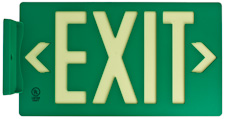 While all fire exit signs are required to be illuminated, not all models require electricity. UL 924 listed fire exit signs are available in AC powered, non-electric self luminous Tritium or photoluminescent models all of which are compliant for use in the United States and Canada.
While all fire exit signs are required to be illuminated, not all models require electricity. UL 924 listed fire exit signs are available in AC powered, non-electric self luminous Tritium or photoluminescent models all of which are compliant for use in the United States and Canada.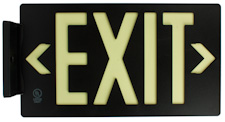 Photoluminescent signs, often referred to as “glow-in-the-dark” signs, absorb and store energy from normal ambient light, then release this energy in the form of a visible glow when the lights go out. Photoluminescent products automatically recharge once the lights are turned on, requiring approximately 60 minutes of exposure to 5 foot-candles or 54 LUX of natural light‡, fluorescent, metal halide or mercury vapor light.
Photoluminescent signs, often referred to as “glow-in-the-dark” signs, absorb and store energy from normal ambient light, then release this energy in the form of a visible glow when the lights go out. Photoluminescent products automatically recharge once the lights are turned on, requiring approximately 60 minutes of exposure to 5 foot-candles or 54 LUX of natural light‡, fluorescent, metal halide or mercury vapor light. 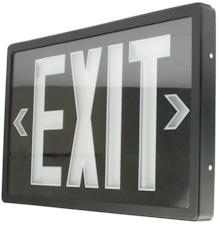 Self-luminous EXIT signs containing the radioactive gas tritium are widely used in a variety of facilities across the United States, such as public and private office buildings, theaters, stores, schools and churches – anywhere the public needs a rapid exit path. Those who possess tritium EXIT signs are general licensees of the Nuclear Regulatory Commission or an Agreement State, and are subject to certain reporting and handling requirements, including proper disposal of unwanted or unused signs. Tritium EXIT signs pose little or no threat to public health and safety and do not constitute a security risk.” —
Self-luminous EXIT signs containing the radioactive gas tritium are widely used in a variety of facilities across the United States, such as public and private office buildings, theaters, stores, schools and churches – anywhere the public needs a rapid exit path. Those who possess tritium EXIT signs are general licensees of the Nuclear Regulatory Commission or an Agreement State, and are subject to certain reporting and handling requirements, including proper disposal of unwanted or unused signs. Tritium EXIT signs pose little or no threat to public health and safety and do not constitute a security risk.” — 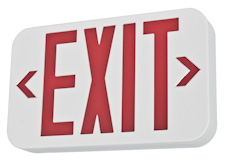 The real function of
The real function of 